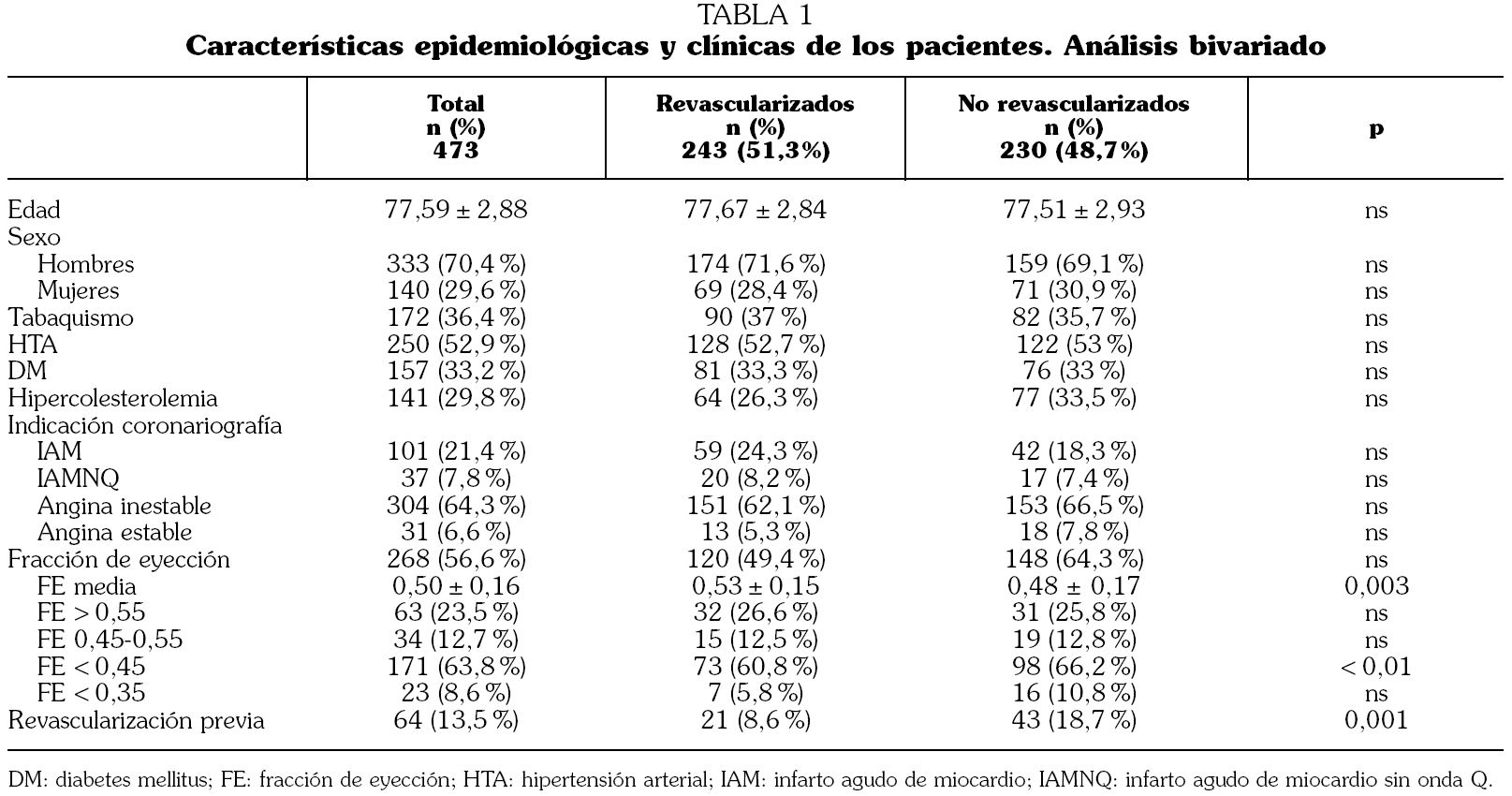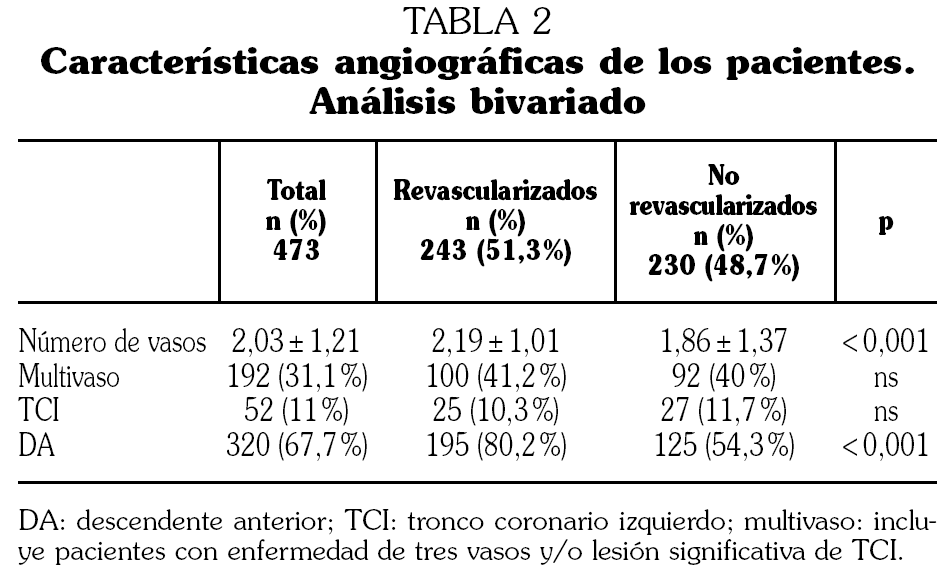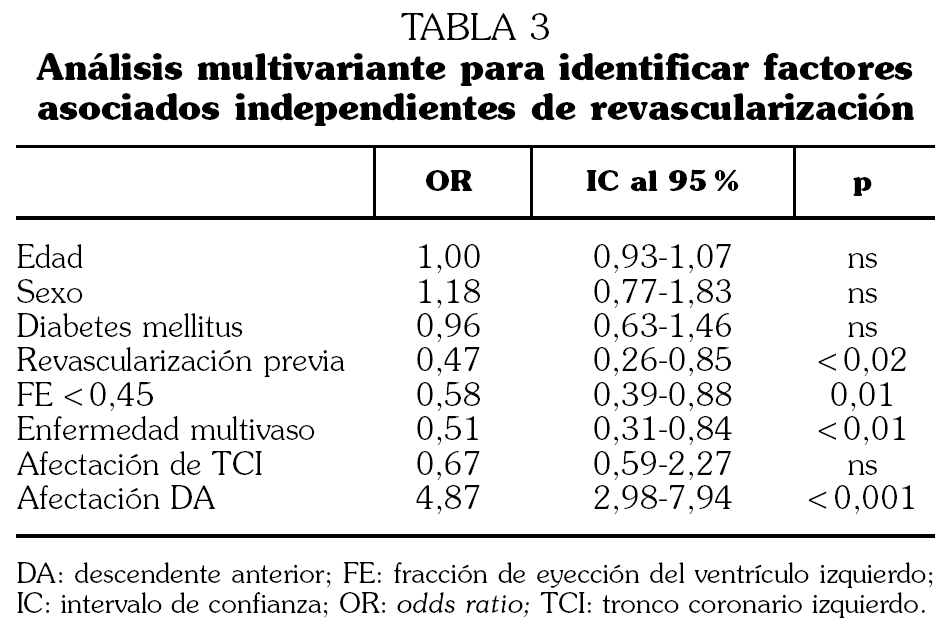Introducción. La incidencia de cardiopatía isquémica en ancianos es elevada. De forma creciente estos pacientes son derivados para coronariografía. Objetivos. Identificar factores asociados con la revascularización coronaria en pacientes ancianos. Material y métodos. Estudio retrospectivo de 473 pacientes ≥ 75 años a los que se realizó coronariografía en relación con cardiopatía isquémica. Se analizaron sus características clinicoepidemiológicas y el tratamiento adoptado. Se utilizó un modelo de análisis multivariante para identificar factores asociados con la revascularización. Resultados. La edad media fue 77,6 ± 2,8 años; el 70,4% fueron varones. El 36% eran fumadores, el 53% hipertensos, el 33% diabéticos y el 30% dislipidémicos. El 31% presentaron enfermedad multivaso y el 11% afectación de tronco coronario izquierdo. En el 68% se evidenció afectación de la descendente anterior. Se realizó tratamiento médico en el 48,4%, revascularización percutánea en 41,5% y quirúrgica en 10,1 %. Los enfermos con lesiones de la descendente anterior fueron revascularizados en mayor proporción: 67,7% frente al 32,3%; p < 0,001. Se utilizó un modelo de regresión logística para identificar predictores de revascularización, obteniendo una relación directa con la afectación de la descendente anterior (OR 4,87; IC al 95%: 2,98-7,94; p < 0,001) e inversa con la revascularización previa (OR: 0,47; IC al 95%: 0,26-0,85; p < 0,02), la disfunción ventricular izquierda (OR: 0,58; IC al 95%: 0,39-0,88; p = 0,01) y la presencia de enfermedad multivaso (OR: 0,51; IC al 95%: 0,31-0,84; p < 0,01). Conclusiones. Los ancianos con cardiopatía isquémica a los que se les realizó coronariografía recibieron tratamiento revascularizador en algo más del 50% de los casos. Se encontró una relación directa entre la afectación de la descendente anterior y la realización de tratamiento revascularizador e inversa entre la revascularización previa, la disfunción ventricular izquierda y la presencia de enfermedad multivaso.
Palabras clave:
ancianos, coronariografía, enfermedad coronaria, revascularización
Introduction. The incidence of ischemic heart disease in the elderly is high. These patients are increasing referred for coronariography. Objectives. Identify factors associated with coronary revascularization in elderly patients. Material and methods. Retrospective study of 473 patients ≥ 75 years who underwent coronariography in relationship with ischemic heart disease. Their clinical-epidemiological characteristics and treatment adopted were analyzed. A multivariate analysis model was used to identify factors associated with revascularization. Results. Mean age was 77.6 ± 2.8 years; 70.4% were men. A total of 36% smoked, 53% were hypertensive, 33% diabetics and 30% dislipidemic. Thirty one % had multivessel disease and 11% involvement of left coronary trunk. There was evidence of anterior descending artery in 68%. Medical treatment was done in 48.4%, percutaneous revascularization in 41.5% and surgical in 10.1%. Patients with lesions of the anterior descending artery were revascularized in greater proportion: 67.7% vs 32.3%; p < 0.001. A logistic regression model was used to identify revascularization predictors, obtaining a direct relationship with the involvement of the anterior descending artery (OR: 4.87; 95% CI: 2.98-7.94; p < 0.001) and inverse one with the previous revascularization (OR: 0.47; 95% CI: 0.26-0.85; p < 0.02), left ventricular dysfunction (OR: 0.58; 95% CI: 0.39-0.88; p = 0.01) and presence of multivessel disease (OR: 0.51; 95% CI: 0.31-0.84; p < 0.01). Conclusions. The elderly subjects with ischemic heart disease who underwent coronariography received revascularizing treatment in somewhat more than 50% of the cases. A direct relationship was found between involvement of the anterior descending artery and performance of revascularizing treatment and an inverse one between previous revascularization, left ventricular dysfunction and presence of multivessel disease.
Keywords:
elderly, coronariography, coronary disease, revascularization










